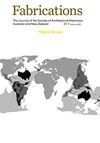Learning from the Opposite? Iberian Journals Glance at Australia
IF 0.2
0 ARCHITECTURE
Fabrications-The Journal of the Society of Architectural Historians Australia and New Zealand
Pub Date : 2021-01-02
DOI:10.1080/10331867.2021.1907028
引用次数: 0
Abstract
ABSTRACT In 1933, Antonio Salazar established the so-called Estado Novo in Portugal. Six years later, Francisco Franco set up a right-wing totalitarian regime in Spain. The heavy traditionalism of both regimes and their rejection by western democracies after the Second World War kept them not only politically isolated, but also intensely invested in the revival of past national symbols. In architecture, such authoritarianism was evident in the return to traditional styles and vernacular models. However, within a decade interest in international architecture expanded. Initially, Iberia looked at more proximate countries in Europe and the Americas, but soon thereafter began to look towards the Pacific, particularly Japan and Australia. Iberian architects showed less interest in the Antipodes than they did towards other countries that were nearer geographically or culturally, such as Brazil or Mexico. Nevertheless, the number of articles about Australian architecture published in local magazines was not negligible, nor was the influence certain Australian works exercised over the career of some young architects. Following the storyline of articles published in Portuguese and Spanish professional journals, this paper presents Iberia’s evolving interest in Australian architecture, precisely the furthest away for them.从反面学习?伊比利亚期刊一瞥澳大利亚
1933年,安东尼奥·萨拉查(Antonio Salazar)在葡萄牙建立了所谓的新庄园。六年后,弗朗西斯科·佛朗哥在西班牙建立了右翼极权主义政权。这两个政权的严重传统主义,以及它们在二战后遭到西方民主国家的排斥,不仅使它们在政治上被孤立,而且还强烈地致力于复兴过去的国家象征。在建筑方面,这种专制主义在回归传统风格和本土模式中表现得很明显。然而,在十年内,对国际建筑的兴趣扩大了。最初,伊比利亚着眼于更近的欧洲和美洲国家,但此后不久开始将目光投向太平洋,特别是日本和澳大利亚。伊比利亚的建筑师对“对跖点”的兴趣不如对其他地理或文化上更接近的国家(如巴西或墨西哥)的兴趣大。然而,在当地杂志上发表的关于澳大利亚建筑的文章的数量是不可忽视的,某些澳大利亚作品对一些年轻建筑师的职业生涯也产生了影响。按照葡萄牙和西班牙专业期刊上发表的文章的故事情节,本文介绍了伊比利亚对澳大利亚建筑的不断发展的兴趣,正是他们最遥远的地方。
本文章由计算机程序翻译,如有差异,请以英文原文为准。
求助全文
约1分钟内获得全文
求助全文
来源期刊

CiteScore
0.50
自引率
25.00%
发文量
26
 求助内容:
求助内容: 应助结果提醒方式:
应助结果提醒方式:


